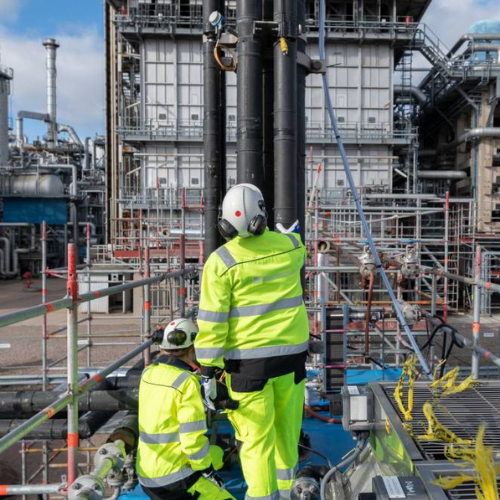Accelerating Carbon Capture Solutions
AURORA Pilot Plants testing CESAR1 solvent
An important part of the AURORA project is to test the CESAR1 solvent in three different existing pilot plants, which differ in their capacity in order to verify scale effects, as well as in their test characteristics.
CO2 laboratory, Tiller – SINTEF
Visit the lab ↓
SINTEF - Tiller laboratory
The CO2 laboratory at Tiller in Trondheim, Norway is a highly equipped test facility for development of post-combustion CO2 capture technologies, as well as a research lab for flue gas pre-treatment analysis and emission research. It is highly flexible and designed for testing different solvents at various flue gas conditions.
Mobile Test Unit – Aker Carbon Capture
Visit the lab ↓
Aker Carbon Capture - MTU
The Mobile Test Unit (MTU) owned by Aker Carbon Capture is a modular CO2 capture test facility. It is easy to transport and integrate with existing process plant facilities, and it generates representative data for industrial CO2 capture applications.
Technology Center Mongstad – TCM
Visit the lab ↓
TCM - industrial park
Technology Centre Mongstad (TCM) is the world’s largest test centre for developing CO2 capture technologies and one of the leading competence centres for carbon capture. TCM is located at a complex industrial facility at the Western coast of Norway.
AURORA experiment
A Collaborative Effort for a Sustainable Future
There are currently various carbon capture routes, which fall into three categories: pre-combustion, post-combustion and oxy-combustion processes.
As post-combustion is the easiest way to integrate carbon capture into existing plants, it has been widely developed in recent years and is well placed for large-scale deployment.
While solid adsorbents and membrane systems struggle to achieve the combined objective of a 90% capture rate and 95% purity, chemical absorption processes can achieve even higher CO2 capture rates than the 90% currently deployed, and even close to 100% without significantly increasing the relative heat input. What’s more, the purity of the CO2 produced in these systems is intrinsically high (over 99%).
The Challenges of Carbon Capture
Optimising and Qualifying CESAR1 solvent
Absorption-based technology needs cost reductions and minimized environmental impacts. To quickly translate research into practical applications and enable the adoption of CCUS in CO2-intensive industries, AURORA partners will optimize and qualify the non-proprietary solvent CESAR1 and its associated process. This will prepare them for the development of first-of-a-kind plants as the next step.

Complete evaluation of the CCUS chain
Our Demonstration Objectives
The project will incorporate new innovations into four optimized CO2 capture processes and demonstrate these in pilot projects of different sizes and complexities. The partners will ensure the results can be applied to other CO2-intensive industries by addressing various CO2 sources and involving numerous stakeholders. Additionally, comprehensive evaluations of the CCUS (carbon capture, utilization, and storage) chain will be conducted for end-users located in two different European regions, each presenting unique conditions for implementing CCUS value chains.
Holistic optimisation of solvent composition, process design, emission monitoring and control, and solvent management.
Validated models for use in commercial process simulators.
Enhanced waste heat integration with carbon capture for reduced external heat demand and operational costs.
Improved and integrated advanced control system for reduced OPEX and optimised performances.
Innovative Solvent Technology
Take closer look at the progress of the AURORA experiment on end-user sites...
On-site flue gas characterization carried out by SINTEF at Motor Oil Refinery in Agioi Theodoroi, Corinthos, Greece
Motor Oil had the pleasure of welcoming its AURORA partners at the Refinery in Agioi Theodoroi, Corinthos, Greece, last week, 11th to 15th March 2024. The whole week was devoted to on-site measurements carried out by SINTEF experts, using specialised instruments for gas and particle analysis on the hydrogen production…
The methodology for full chain CCUS assessment and cluster development is established
The first deliverable of Work Package 5 on the Full chain CCUS assessment has been issued. This report results from continuous discussions and workshop between all partners during the first year. It is co-authored by TotalEnergies, SINTEF, UNIROMA1 and Cambridge University. Links between the different blocks of a full CCUS…
The methodology for assessment of the AURORA technology and qualification of the CESAR1 solvent is established
The final aim of the AURORA project is to qualify the CESAR1 solvent for commercial deployment and to establish this solvent and its associated absorption process as the new benchmark for CO2 capture. This requires that the performance of the solvent is known and that any risks in the deployment of…
Getting ready: Motor Oil and HERACLES set date for onsite flue gas characterization with SINTEF experts!
The Motor Oil refinery and the HERACLES cement plant in Greece are both preparing on site and have set dates in March 2024 for flue gas characterization with SINTEF experts. An in-depth analysis will be carried out respectively on the hydrogen production unit and the kiln stack. HERACLES cement plant,…
Installation and operation of the MTU (Mobile test Unit) pilot unit at the Volos plant
During the period January-September 2023, the HERACLES team carried out the authorisation procedures for the installation and operation of the MTU pilot unit at the Volos plant. The HERACLES team worked with its partners on on-site flue gas characterisation and on the methodology for evaluating and technologically qualifying large-scale capture…








